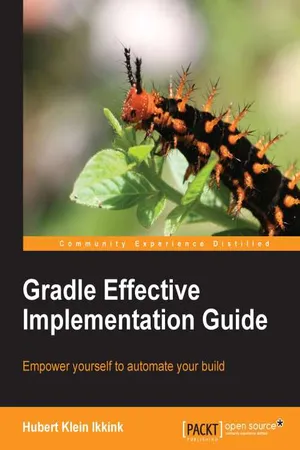![]()
Gradle Effective Implementation Guide
![]()
Table of Contents
Gradle Effective Implementation Guide
Credits
About the Author
Acknowledgement
About the Reviewers
www.PacktPub.com
Support files, eBooks, discount offers and more
Why Subscribe?
Free Access for Packt account holders
Preface
What this book covers
What you need for this book
Who this book is for
Conventions
Reader feedback
Customer support
Downloading the example code
Errata
Piracy
Questions
1. Starting with Gradle
Introducing Gradle
Declarative builds and convention over configuration
Support for Ant tasks and Maven repositories
Incremental builds
Multi-project builds
Gradle wrapper
Free and open source
Getting started
Installing Gradle
Writing our first build script
Default Gradle tasks
Task name abbreviation
Executing multiple tasks
Command-line options
Logging options
Changing the build file and directory
Running tasks without execution
Gradle daemon
Profiling
Understanding the Gradle user interface
Task Tree
Favorites
Command Line
Setup
Summary
2. Creating Gradle Build Scripts
Writing a build script
Defining tasks
Defining actions with the Action interface
Build scripts are Groovy code
Defining dependencies between tasks
Defining dependencies via tasks
Defining dependencies via closures
Setting default tasks
Organizing tasks
Adding a description to tasks
Grouping tasks together
Adding tasks in other ways
Using task rules
Accessing tasks as project properties
Adding additional properties to tasks
Avoiding common pitfalls
Skipping tasks
Using onlyIf predicates
Skipping tasks by throwing StopExecutionException
Enabling and disabling tasks
Skipping from the command line
Skipping tasks that are up-to-date
Summary
3. Working with Gradle Build Scripts
Working with files
Locating files
Using file collections
Working with file trees
Copying files
Renaming files
Filtering files
Archiving files
Project properties
Defining custom properties in script
Passing properties via the command line
Defining properties via system properties
Adding properties via environment variables
Defining properties using an external file
Using logging
Controlling output
Using the Gradle wrapper
Creating wrapper scripts
Customizing the Gradle wrapper
Summary
4. Using Gradle for Java Projects
Using plugins
Getting started
Using the Java plugin
Working with source sets
Creating a new source set
Custom configuration
Working with properties
Creating documentation
Assembling archives
Summary
5. Dependency Management
Dependency configuration
Repositories
Adding Maven repositories
Adding Ivy repositories
Adding a local directory repository
Defining dependencies
Using external module dependencies
Using project dependencies
Using file dependencies
Using client module dependencies
Using Gradle and Groovy dependencies
Accessing configuration dependencies
Setting dynamic versions
Resolving version conflicts
Adding optional ANT tasks
Using dependency configurations as files
Summary
6. Testing, Building, and Publishing Artifacts
Testing
Using TestNG for testing
Configuring the test process
Determining tests
Logging test output
Generating test reports
Running Java applications
Running an application from a project
Running an application as task
Running an application with the application plugin
Creating a distributable application archive
Publishing artifacts
Uploading to a Maven repository
Multiple artifacts
Signing artifacts
Publishing signature files
Configuring conditional signing
Packaging Java Enterprise Edition applications
Creating a WAR file
Using the War plugin
Creating an EAR file
Using the Ear plugin
Summary
7. Multi-project Builds
Working with multi-project builds
Executing tasks by project path
Using a flat layout
Defining projects
Filtering projects
Defining task dependencies between projects
Defining configuration dependencies
Working with Java multi-project builds
Using partial builds
Using the Jetty plugin
Summary
8. Mixed Languages
Using the Groovy plugin
Creating documentation with the Groovy plugin
Using the Scala plugin
Creating documentation with the Scala plugin
Summary
9. Maintaining Code Quality
Using the Checkstyle plugin
Using the PMD plugin
Using the FindBugs plugin
Using the JDepend plugin
Using the CodeNarc plugin
Using the Sonar plugin
Summary
10. Writing Custom Tasks and Plugins
Creating a custom task
Creating a custom task in the build file
Using incremental build support
Creating a task in the project source directory
Writing tests
Creating a task in a standalone project
Creating a custom plugin
Creating a plugin in the build file
Creating a plugin in the project source directory
Testing a plugin
Creating a plugin in a standalone project
Summary
11. Using Gradle with Continuous Integration
Creating a sample project
Using Jenkins
Adding the Gradle plugin
Configuring Jenkins job
Running the job
Configuring artifacts and test results
Adding Gradle versions
Using JetBrains TeamCity
Creating a project
Running the project
Using Atlassian Bamboo
Defi...
